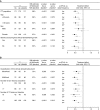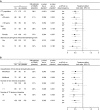Patient subgroup analyses of the treatment effect of subcutaneous interferon β-1a on development of multiple sclerosis in the randomized controlled REFLEX study
- PMID: 24413638
- PMCID: PMC3948518
- DOI: 10.1007/s00415-013-7222-6
Patient subgroup analyses of the treatment effect of subcutaneous interferon β-1a on development of multiple sclerosis in the randomized controlled REFLEX study
Abstract
The REFLEX study (NCT00404352) established that subcutaneous (sc) interferon (IFN) β-1a reduced the risks of McDonald MS (2005 criteria) and clinically definite multiple sclerosis (CDMS) in patients with a first clinical demyelinating event suggestive of MS. The aim of this subgroup analysis was to assess the treatment effect of sc IFN β-1a in patient subgroups defined by baseline disease and demographic characteristics (age, sex, use of steroids at the first event, classification of first event as mono- or multifocal, presence/absence of gadolinium-enhancing lesions, count of <9 or ≥9 T2 lesions), and by diagnosis of MS using the revised McDonald 2010 MS criteria. Patients were randomized to the serum-free formulation of IFN β-1a, 44 μg sc three times weekly or once weekly, or placebo, for 24 months or until diagnosis of CDMS. Treatment effects of sc IFN β-1a on McDonald 2005 MS and CDMS in the predefined subgroups were similar to effects found in the intent-to-treat population. McDonald 2010 MS was retrospectively diagnosed in 37.7 % of patients at baseline. Both regimens of sc IFN β-1a significantly reduced the risk versus placebo of McDonald 2005 MS and CDMS, irrespective of McDonald 2010 status at baseline (risk reductions between 29 and 51 %). The effect of sc IFN β-1a was not substantially influenced by baseline patient demographic and disease characteristics, or baseline presence/absence of McDonald 2010 MS.
Figures






Similar articles
-
Comparison of two dosing frequencies of subcutaneous interferon beta-1a in patients with a first clinical demyelinating event suggestive of multiple sclerosis (REFLEX): a phase 3 randomised controlled trial.Lancet Neurol. 2012 Jan;11(1):33-41. doi: 10.1016/S1474-4422(11)70262-9. Epub 2011 Dec 4. Lancet Neurol. 2012. PMID: 22146409 Clinical Trial.
-
Subcutaneous interferon β-1a in the treatment of clinically isolated syndromes: 3-year and 5-year results of the phase III dosing frequency-blind multicentre REFLEXION study.J Neurol Neurosurg Psychiatry. 2017 Apr;88(4):285-294. doi: 10.1136/jnnp-2016-314843. Epub 2016 Dec 30. J Neurol Neurosurg Psychiatry. 2017. PMID: 28039317 Clinical Trial.
-
Evolution from a first clinical demyelinating event to multiple sclerosis in the REFLEX trial: Regional susceptibility in the conversion to multiple sclerosis at disease onset and its amenability to subcutaneous interferon beta-1a.Eur J Neurol. 2022 Jul;29(7):2024-2035. doi: 10.1111/ene.15314. Epub 2022 Apr 4. Eur J Neurol. 2022. PMID: 35274413 Free PMC article. Clinical Trial.
-
Subcutaneous recombinant interferon-β-1a (Rebif®): a review of its use in the treatment of relapsing multiple sclerosis.Drugs. 2011 Oct 1;71(14):1865-91. doi: 10.2165/11207540-000000000-00000. Drugs. 2011. PMID: 21942977 Review.
-
Interferon-beta-1b: a review of its use in relapsing-remitting and secondary progressive multiple sclerosis.CNS Drugs. 2004;18(8):521-46. doi: 10.2165/00023210-200418080-00004. CNS Drugs. 2004. PMID: 15182221 Review.
Cited by
-
Patterns of autoantibody expression in multiple sclerosis identified through development of an autoantigen discovery technology.J Clin Invest. 2025 Mar 3;135(5):e171948. doi: 10.1172/JCI171948. J Clin Invest. 2025. PMID: 40026247 Free PMC article. Clinical Trial.
-
Drug Treatment of Clinically Isolated Syndrome.CNS Drugs. 2019 Jul;33(7):659-676. doi: 10.1007/s40263-019-00647-x. CNS Drugs. 2019. PMID: 31290079 Review.
-
Treatment with disease-modifying drugs for people with a first clinical attack suggestive of multiple sclerosis.Cochrane Database Syst Rev. 2017 Apr 25;4(4):CD012200. doi: 10.1002/14651858.CD012200.pub2. Cochrane Database Syst Rev. 2017. PMID: 28440858 Free PMC article.
-
Clinical Parameters to Predict Future Clinical Disease Activity After Treatment Change to Higher-Dose Subcutaneous Interferon Beta-1a From Other Platform Injectables in Patients With Relapsing-Remitting Multiple Sclerosis.Front Neurol. 2020 Sep 2;11:944. doi: 10.3389/fneur.2020.00944. eCollection 2020. Front Neurol. 2020. PMID: 32982947 Free PMC article.
-
Plasma Exchange or Immunoadsorption in Demyelinating Diseases: A Meta-Analysis.J Clin Med. 2020 May 25;9(5):1597. doi: 10.3390/jcm9051597. J Clin Med. 2020. PMID: 32466101 Free PMC article.
References
-
- Brex PA, Miszkiel KA, O’Riordan JI, Plant GT, Moseley IF, Thompson AJ, Miller DH. Assessing the risk of early multiple sclerosis in patients with clinically isolated syndromes: the role of a follow up MRI. J Neurol Neurosurg Psychiatry. 2001;70:390–393. doi: 10.1136/jnnp.70.3.390. - DOI - PMC - PubMed
-
- Tintoré M, Rovira A, Rio J, Nos C, Grivé E, Téllez N, Pelayo R, Comabella M, Sastre-Garriga J, Montalban X. Baseline MRI predicts future attacks and disability in clinically isolated syndromes. Neurology. 2006;67:968–972. doi: 10.1212/01.wnl.0000237354.10144.ec. - DOI - PubMed
Publication types
MeSH terms
Substances
Associated data
LinkOut - more resources
Full Text Sources
Other Literature Sources
Medical

